

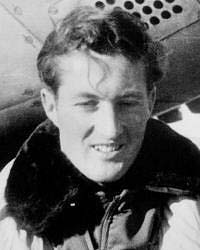
Keith Meggs: A Man and his MachinesKeith Meggs began work at Commonwealth Aircraft Corporation early in 1943 as a teenager, and began gliding at the end of 1945.In August 1948 he joined the Royal Australian Air Force for flying training, and subsequently flew Mustangs and later Meteor Mk.8 jets in the Korean War, earning the DFM and AAM. Following this he flew Vampires in Australia and Malta. Keith rejoined the Commonwealth Aircraft Corporation in 1957 working for several years on Sabres and the Ceres cropduster. He then joined the Department of Civil Aviation as an Air Traffic Controller before taking up freelance charter flying, which lasted some 25 years and culminated in a grand total of 19,460 hours attained on 109 types of aircraft. A foundation member of the Aviation Historical Society of Australia in 1959, Keith has been President since 1988. In recent years, Keith's time has been taken up in researching and writing the four volume series Australian Built Aircraft and the Industry. Image: Sgt. K.R. Meggs, 77 Squadron RAAF, Pusan, Korea Photographer: George Odgers. AWM Negative Number: P1254/162/108
The MachinesCAC-built, North American Mustang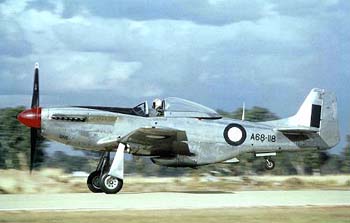 CA-18 North American Mustang (A68-118) : RAAF Museum http://freespace.virgin.net/barry.hobson/warbirds.html Read more about the CAC-built, North American Mustang Please note that it may take a short while to load all the images on this page
Gloster MeteorGloster Meteor F.Mk.8s, 77 Squadron RAAF, Korea, c.1951 photo courtesy of Keith Meggs Read more about the Gloster Meteor Please note that it may take a short while to load all the images on this page
CAC Avon Sabre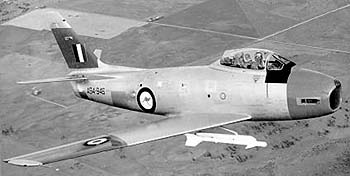 CA-27 Avon Sabre (A94-945) http://www.defence.gov.au/ardu/history.htm Read more about the CAC Avon Sabre Please note that it may take a short while to load all the images on this page
de Havilland Vampirede Havilland Vampire (A79-308) photo courtesy of Keith Meggs Read more about the de Havilland Vampire Please note that it may take a short while to load all the images on this page
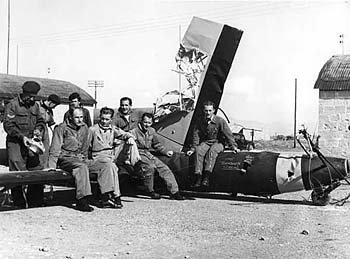 Members of 78 Wing RAAF, Nicosia, Cyprus, c.1952
L to R: Cpl. Tony Gillies from Punchbowl, N.S.W., P/O Reg Jones from Sydney, N.S.W, F/O Les Reading DFC from Perth, W.A., F/O Lyall Klaffer from Adelaide, S.A., Group Captain Brian Eaton DSO, DFC from Canterbury, Vic. and P/O Keith Meggs DFM from Preston, Vic. in Nicosia, Cyprus State Library of Victoria., Library Record Number: 1198049, Accession Number: H99.206/1545
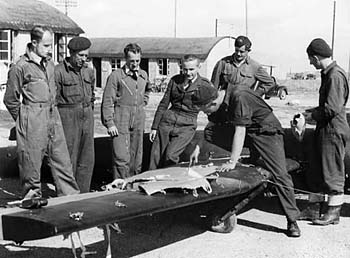 Members of 78 Wing RAAF, Nicosia, Cyprus, c.1952
L to R: P/O Reg Jones from Sydney, N.S.W., Cpl. Tony Gillies of Punchbowl, N.S.W., P/O Keith Meggs DFM from Preston, Vic., a Czech pilot; LAC Don Chinnery from Newcastle, N.S.W., LAC P Flugrath from Brisbane and LAC neville Johnson of Kogarah, N.S.W. (presumably, though not stated to also be in Nicosia, Cyprus) State Library of Victoria., Library Record Number: 1198049, Accession Number: H99.206/1546
77 Squadron pilots being addressed before a mission by Squadron Leader Dick Creswell Odgers, George. Across the Parallel: The Australian 77th Squadron with the United States Air Force in the Korean War. Melbourne: William Heinemann Ltd, 1953
L to R : Flt Lt 'Joe' Blyth (Royal Air Force), Flt Lt Max Scannell (Royal Air Force), Sgt Ron Mitchell, Sgt Keith Meggs, Sgt Cec Sly, Sqn Ldr Dick Cresswell (addressing the pilots pre-mission), W Off Bill Michelson, Flg Off Les Reading, Sgt Dick Bessell, Flt Lt 'Smokey' Dawson, W Off Bill Middlemiss, Sgt 'Blue' Colebrook, Flt Lt Des Murphy; [Names supplied by Keith Meggs August 2001]
77 Squadron pilots. L to R: P/O Bill Simmons, P/O Don Robertson, Sgt. Tony Armstrong and Sgt Geoff Lushey Odgers, George. Across the Parallel: The Australian 77th Squadron with the United States Air Force in the Korean War. Melbourne: William Heinemann Ltd, 1953
and some ten years ! earlier...
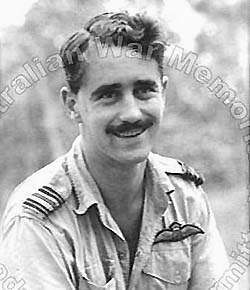 Squadron Leader R.C. (Dick) Creswell photographed only hours after he downed a Japanese heavy bomber during a night raid on Darwin, Dec. 2, 1942 Australian War Memorial Negative Number 013722. (Donor McNeil)
The Royal Australian AirforceThe RAAF: A Historyhttp://www.ozemail.com.au/~rwalpole/raafmus/his_raaf.htm excerpt Several months after WWII some RAAF men were still serving overseas - with the British Commonwealth Occupation force in Japan - alongside their American allies. A fighter wing consisting of Nos. 76, 77 and 82 Squadrons equipped with Mustang fighters went to Japan from North Borneo in March 1946. Three years later Nos. 76 and 82 Squadrons were brought home to Australia, leaving No. 77 at Iwakuni. It was still the sole RAAF squadron in Japan when the Korean War broke out on 25 June 1950. The squadron's aircraft were being prepared for the sea trip home. They were immediately restored to operational readiness and No. 77 Squadron had the honour of being the first allied squadron to go into action with the Americans. Using rockets and cannon, the Australians served in the ground attack role, moving from Iwakuni, Japan, to Pohang on the east coast of Korea in October 1950, and further north to Yonpo a month later as the Allies advanced northward. With China's entry into the war the allies were pushed south again and No. 77 Squadron established itself at Pusan, finally returning to Japan in April 1951, to re-equip with Gloster Meteor 8 fighters which the Australian Government had bought from Britain to replace the aging Mustangs. The twin-jet Meteor, however, was inferior to the Russian-built MiG 15 interceptors which the Chinese were using in increasing numbers. On their return to South Korea in July 1951, the No. 77 Squadron pilots operated from Kimpo, near the capital, Seoul, but found their Meteors were outclassed by the MiGs. So, in January 1952, after losing several Meteors, the squadron's role was switched from interception to ground attack. The Meteors proved to be excellent aircraft for the purpose and were concentrated mainly against enemy supply routes, although they also attacked permanent installations. The Korean War ended on 27 July 1953. In three years No. 77 Squadron had lost 42 pilots (32 in Meteors) while flying 4,836 missions (18,872 individual sorties), destroying 3,700 buildings, 1,500 vehicles and six enemy aircraft. RAAF Douglas Dakotas of No. 30 Transport Unit (later to become No. 36 Squadron), also served in Korea, carrying passengers, mail and freight. In the medical evacuation role alone the Dakotas carried a total of 12,000 wounded troops out of Korea. Malta The strategic importance to Britain of Malta in the Mediterranean prompted the Australian Government, in March 1952, to agree to the contribution of a fighter wing equipped with RAF DH Vampires, for garrison duty there in support of the RAF. The men, of No. 78 Wing, left Australia in July that year and remained in Malta for two years. The wing took part in allied exercises over Europe and North Africa and represented the RAAF at the Coronation of Queen Elizabeth II in London in 1953. also see...
77 Squadron RAAF
77 Squadron RAAF
Air Command Flying Squadrons
Australian Aviation History
The RAAF: A Short History
The RAAF In KoreaAustralian Involvement: Korean Warhttp://www.awm.gov.au/atwar/conflict_korea.htm
Korea Remembered Annotated IndexWar In The Air: The RAAF In Korea Part 1 http://www.awm.gov.au/korea/ausinkorea/raaf/raaf.htm
"I wasn't new to operational command nor to the ground attack role except this war in Korea was a very different, and very ugly, war."RAAF units in the Korean War
91 Composite WingJust a week into the Korean War, airmen of 77 Squadron, who had been stationed in Japan with the British Commonwealth Occupying Force (BCOF), were flying ground-attack missions and bomber escorts from Iwakuni, Japan. Soon the squadron moved from Japan to a succession of bases in Korea as the UN forces advanced and then retreated - Taegu, Pohang, Hamhung (North Korea), Pusan and Kimpo. The squadron was praised for its skill and courage during thousands of flights made during the war. After the success of the Inchon landing, the air force provided crucial support in relieving some of the pressure on ground troops. Pilots from 77 Squadron ranged far and wide over the Korean peninsula, providing cover for the advancing US Eight Army as well as making their own attacks on North Korean forces. Many bombing attacks severely disrupted the progress of enemy ground forces. The main targets for air attack included North Korean railway lines, roads, military installations and vehicles. Initially pilots were equipped with propeller-driven P-51 Mustang fighters used during the Second World War; their weapons were bombs, rockets, machine-guns and napalm. Although the combined UN forces' airpower was superior to North Korea's, the entry of the Chinese into the war made the situation in the air more complicated. They too had airpower, and to the dismay of the UN forces, superior aircraft - MiG-15 jet fighters. In response, 77 Squadron had to switch from flying Mustangs to Meteor jets. Chinese ground forces were more skilled than the North Korean forces in avoiding the damage caused by UN airpower. They were more mobile, better camouflaged, better able to cross large distances quickly, and were less reliant on supply networks, scrounging for food and other supplies as they travelled. The death of 77 Squadron's commanding officer, Wing Commander Lou Spence, just over two months into the war on 9 September 1950, sent a shock through the squadron. He was shot down during a ground attack over Angang-ni. Spence was replaced by Wing Commander Dick Cresswell. On 1 December 1951, fourteen Meteor jets of 77 Squadron were attacked by some fifty MiG-15s high over North Korea. At least one MiG was shot down, the first victory by a Meteor, but three Australian pilots were downed. One of the three was Sergeant Vance Drummond, who landed in enemy territory south-east of Pyongyang and was taken prisoner (POW). In 1952, UN strategy shifted to "air pressure" - an attempt to force the Chinese into battle and defeat them. The improvement of the Chinese and North Korean anti-aircraft weapons increased the danger of this campaign. In the final stages of the war, the strategy of air pressure concentrated on the destruction of ground targets - an area where UN airpower continued to be successful. At times the weather was just as hazardous to pilots as flying under attack. Taking off was difficult in winter: thick ice and snow had to be removed each morning from the aircraft. In the event of ditching in the sea, pilots' immersion suits gave them only a few minutes to be rescued before the freezing water temperature would kill them. The heat of summer created problems as well: sometimes bitumen would melt onto the underside of aircraft during take-off and landing. The humid summer haze extended into the atmosphere up to 1,000 metres, cutting visibility to less than three kilometres. The pilots of 77 Squadron flew almost 19,000 individual sorties while in Korea. Their performance also reaped diplomatic rewards: their excellent reputation played a large role in the signing of the ANZUS pact. Yet despite their successes, during three years of operations 77 Squadron paid a high price. Forty pilots were killed - 30 killed in action, eight in accidents, and two in accidents on the ground. Six were captured and became POWs. Of the squadron's 90 Meteors, 54 were lost during the war.
War In The Air: The RAAF In Korea Part 2
by Bill Parsons, US 187th Airborne http://www.kmike.com/oz/aussiesome.htm RAAF's Mustangs from 77 Squadron (which had been on duty with the occupation forces in Japan) initially provided much of the close air support for the beleaguered United Nations ground forces. Later re-equipped with the British-made Gloster Meteor jet fighter, 77 Squadron continued to operate in Korea as part of the United States Fifth Air Force. Although initially operating behind propellers, their work was professional, effective, and ... appreciated. Day two of the Sukchon drop. We were making our way up a hill, trying to stay out of the line of fire of a NK self-propelled 76 that kept lobbing rounds in our direction. Really couldn't tell if we were the targets or not, since the rounds seemed to be going over us and not into us. Perhaps the SP could not depress his gun enough due to being dug in or perhaps he was just letting us know he was still in the war. After a time of hitting the dirt and climbing, repeat, repeat, the Platoon Sgt. got a little weary of the game and got on the radio to see if there was any air support in the area. Right away we had contact with a voice speaking with a decidedly English accent, informing us that they were almost over the area and could we put out some smoke so they could spot our position. We did and in short order a flight of Mustangs with Australian markings barreled by very close overhead. Almost immediately our Aussie friend inquired if we had our air strike panels out. We didn't, what with climbing and ducking we had forgotten. "I say, mates, if we don't see your panels, we don't really know if you threw the smoke or not. From up here all you people look the same to us." Out went the panels, quickly! Telling the pilots the general direction we figured the rounds were coming from, they circled at a higher altitude until the SP fired again. "OK, Yanks, we have him spotted, pull in your heads and we will fix the bugger." With that the entire flight peeled off and came down firing all the ordinance they had. One pass and we could hear the SP self-destructing in the distance. We sincerely thanked our Aussie mates and they gave us a victory roll as an acknowledgment. For air support, those countries flying the P-51's were far and away the most efficient. The prop jobs could get in and out of the valleys and hills quite easily while the jets just moved too fast to negotiate the terrain. In my personal experience, the Aussies and Brits and South African pilots were very courageous and totally lacking in caution. If you had a target for them, they took it out and were happy to help.
Excerpt, Page 2 of 5 ; 77th Squadron of the Royal Australian Air Force NB: the source site also carries a number of images not shown here Upon the departure of the 49th Fighter-Bomber Wing from Kunsan in 1953, the 77th Squadron of the Royal Australian Air Force from Iwakuni, Japan assumed the air interceptor role for the base defense as a TDY unit. The pilots and ground crews stood by in constant readiness to scramble at a moment's notice. The TDY was on a monthly rotation. The 77th Squadron was formed in 1942 and fought in New Guinea and through the Philippines finally ending up in Japan on Occupation duty. It was at Iwakuni AB, Japan when the Korean War broke out. As a result, was hurriedly attached to the 8th Fighter Bomber Wing and flew missions from Iwakuni. The 77th Squadron was attached until October 1950, when it was sent to Pohang and various other bases in Korea. It returned to Iwakuni, but returned to Kimpo after Seoul was retaken in June 1951. The 77th Squadron remained at Kimpo AB (K-14) until March 1954, when it was sent to Kunsan to replace the departing 49 FBW F-84s. However, in actuality, the unit was really stationed at Iwakuni, Japan and personnel only rotated to Kunsan on a monthly basis. Flying Gloster "Meteor" Mk.8 jet fighter, they flew their missions from the "C" Pad area (Contingency Pad). Doug Hutchison, one of those Aussies at K-8 recollected,
"As near as I can recall our C pad was tucked in behind the control tower and we had nissan hangars. The other RAAF area you refer to was our living and messing quarters this was roughly at a 45 degree angle behind the ORs mess and at the Kunsan end of the strip."Though the tower has relocated about a half-mile north, the "C" pad is in about the same place as the current "C" pad (Contingency Pad), though the control tower has relocated north to the intersection of Taxiway Charlie and the Main runway. The RAAF billeting/mess area was located where the present Kunsan Gas Station is located at the north end of the runway. Note that the "nissan hangars" where the 77 Squadron RAAF was located was taken over by the deployed elements of the 3rd Bomb Wing from Japan between 1958-1964 for standing of nuclear alerts at Kunsan. He wrote,
"One very funny incident comes to mind every time I think of K8 and that was a notice that was permanently fixed in the airmen's toilet. It simply read: "Please do not throw your cigarette butts in the pissophones, it makes them soggy and hard to light". It was the most photographed notice in Korea. Also I recall a B26 doing a nose wheel up landing late one afternoon but, fortunately, no injuries. You may recall two of our Meteors colliding with one pilot killed."He continued later,
"I remember that our aircraft dispersal area was not far from a very large bomb dump. An American friend that comes to mind was PFC "Tex" Edkin he was from Houston and was with the 5th Motor Transport Sqdn (5th Mule Train) he spent a lot of time with us as he delivered a lot of equipment to us.Ellie E. Price of the 841st EAB remembered the Aussies. He wrote,
"Yep, there were Aussies there in '54 and a great lot they were, mate, eh. They wore those wide brimmed outback hats on the flight line and seemed to like us."From his comments, it appears the Aussies liked to party hard as well. Ellie relates about one party thrown by the Aussies where he was hauled back to his tent by his buddies, but the next morning, he discovered that some others had not been so lucky. They were still passed out in ditches. Unlike the U.S. Air Force whom the Marines disliked intensely, the Marine of MACS-1 were on good terms with the 77 Squadron RAAF. Joseph Smuts stated,
"The Aussies of the 77th RAAF, on the other hand, were a horse of a different color. They were frequent visitors to the site and always welcome. Good people and fond memories."Fifty years later and it's nice that people still think well of them. Joe also contributed a newsletter about the MACS-1 close cooperation with the Aussie group. It details the saving an Aussie aircraft from ditching at sea and a friendly drill competition between the units. When the threat from North Korea diminished, the Aussies finally went home. The 77 Sqdn.departed Korea on October 16th 1954 for Iwakuni. Then finally the last elements went home to Australia in November 1954 -- over four years late. It departed Japan by ship November 1954 and arrived back in Australia on 3rd December 1954. As a final note, Doug Hutchinson wrote,
"We have only just opened our Korean War Memorial, April 2000, but better late than never. It really is a nice memorial though."
http://www.awm.gov.au/korea/ausinkorea/contributions.htm
The RAAF in the Korean WarCoalition Warfare: Ch.2: The Korean War: Australiaby Peter Hunt http://www.fas.org/man/eprint/hunt.htm Excerpts from the above... Airpower in the Korean War "...Because the North Koreans advanced so rapidly in the opening days of the war, General Douglas MacArthur, the Commander-in-Chief, Far East (CINCFE), realized the need for airpower to stem the tide of advance. Aside from USAF squadrons in Japan, both Australia and Great Britain had airpower assets in theater during the opening weeks of the war. Even before American ground troops arrived in Korea on July 2nd, coalition airpower supported the US-led effort to defend the peninsula. In Japan, F-51D Mustangs of the Royal Australian Air Force (RAAF) 77 Squadron formed part of the post-war British Commonwealth Occupation Force (BCOF). Ironically, they flew their last sorties of the occupation mission on June 23, 1950, in preparation for their return to Australia. The squadron was enjoying a farewell celebration when news of the North Korean invasion reached them. Within a week, the squadron was flying escort for USAF B-26 Invader bombing missions. Eventually, 77 Squadron flew a variety of missions in both the F-51D and the British-made Gloster Meteor Mk.8 jet fighter..." Political Objectives "...After World War II, Australia readdressed its security concerns from both regional and global perspectives. They sought security via three main avenues: US support, support for British interests, and strong self-defense. After the Korean War broke out, Australia worked to build its security in each of these areas. First, Australia highlighted the early contribution of 77 Squadron to pressure the US to agree to the Australia-New Zealand-United States (ANZUS) security pact. Prime Minister Robert Menzies spoke to the US House of Representatives on August 1, 1950 and the Minister for External Affairs, Percy Spender, spoke with President Truman a month later. Spender's conversation "was the real turning point which led to the ANZUS Treaty." Second, Australia's support of British interests gradually put Korea in the background. When debating whether to intervene in Korea, the Australian government stressed the importance of Commonwealth solidarity. Since the spring of 1950, Britain had pressured Australia for military assistance in surpressing the Malayan insurgency. Two days after the North Korean invasion, the Australian cabinet decided to send Lincoln bombers to Malaya, where London thought the main Communist threat lay. As the Korean situation stabilized in late 1951, the main Australian commitment overseas was toward British interests in Southeast Asia, not Korea. These Australian policy objectives directly influenced the RAAF commitment in Korea. As the casualty rate and financial costs for 77 Squadron rose, the Australian Minister for Air suggested withdrawing the squadron from Korea. In rejecting this proposal, Prime Minister Menzies took a broader view of security issues and US-Australian relations. He crafted a limited, yet symbolic commitment to the UN effort that gained long-term benefits for Australia...." Airpower Objectives "...Unlike the strict British government oversight of its forces' operations, the RAAF operated with less political control. When MacArthur pressed the BCOF for an early commitment of 77 Squadron to Korea, his use of the media (instead of political channels) to sound the request understandably upset Australian officials. During the war, RAAF headquarters provided little operational guidance, primarily because Australia had no officers above the rank of wing commander on the UN command or US staffs. Occasionally, RAAF headquarters pressed 77 Squadron to match the flying rate of the Americans. In December 1950, General Partridge and Lieutenant General George Stratemeyer, Far East Air Force (FEAF) commander, visited 77 Squadron in Iwakuni, Japan. Headquarters RAAF staff officers who were also visiting Iwakuni complained to Partridge about trivial items such as the daily sortie rate. Partridge realized that the Australians were overly focused on tactical-level problems. The Australians were apparently unaware of the host USAF wing's activity at Iwakuni, and did not realize that General Stratemeyer had accompanied Partridge to the air base, precisely to assess air operations. On one occasion, coalition airpower objectives clashed when a member introduced new equipment in theater. When 77 Squadron converted from the F-51D to the Gloster Meteor Mk. 8 in July 1951, the USAF and the RAAF disagreed about the missions for which the new aircraft was best suited. This debate was closely tied to the perceived capability of the new jet fighter and its appropriate role in the changing air situation. Keith Meggs comments: 77 Squadron was in Japan for the conversion from April 7 to the end of July 1951 with the first Meteor mission from Kimpo being flown on July 29 When high-performance Chinese MiG-15 fighters appeared over Korea in November 1950, General Partridge (and the RAF) encouraged the RAAF to acquire the British-built Meteor. Keith Meggs comments: Sabres could not be supplied to the RAAF at that stage The 77 Squadron commander intended to use the Meteor in its designed interceptor role. When the swept-wing F-86 outperformed the Meteor in flyoffs, the USAF doubted the ability of Meteors to successfully engage MiG-15s. Thereafter, "a heated argument raged between Americans and Aussies over how the Meteor should be used." Keith Meggs comments: In mock combat at Iwakuni, the Meteor outclimbed the Sabre and I think could out turn it at low level. In the event, MiG-15s shot down several Meteors in July alone.
Keith Meggs comments: The first loss was not until August 29. The pilot, WO Ron Guthrie, was a POW till the end of the war. Warrant Officer Ron Guthrie, April 1951 On August 29, 1951, Australian Warrant Officer Ron Guthrie's Meteor was shot down by a MiG jet. He ejected at 38,300 ft, parachuted through freezing air for over 20 minutes, but landed unhurt. He was immediately captured by North Korean soldiers, and taken prisoner of war. Image: Australian War Memorial Negative No. JK0927
Everest gave qualified approval to this concept, and soon tasked Meteors for surface attack missions against selected targets, for which they were far better suited...." Airpower Capabilities "...The varying airpower capabilities that coalition members offer may be easier to reconcile than the divergent objectives of the same members. In Korea, several air forces provided unique capabilities that bridged gaps which the US could not fill. Even the comprehensive US air forces suffered from shortfalls which proved critical at the onset of war. Capability includes more than simply aircraft performance, and the defensively-focused USAF units in Japan neglected training for night ground attack missions. Realizing this deficiency, General Stratemeyer asked the RAF Chief of the Air Staff for the loan of an officer experienced in that art to help train the US crews. The most striking US weakness, however, was the lack of suitable ground attack aircraft that could strike targets in Korea from friendly bases in Japan. By 1950, the USAF had equipped many Japan-based units with jet fighters, whose short endurance provided only minutes of loiter time over Korean territory. Coalition airpower, particularly the RAAF Mustangs of 77 Squadron, supplemented the limited USAF capability in this mission. From Japan, Australian Mustangs initially escorted US bombers to Korea. The larger payload and range of the Mustang compared to the USAF F-80 made it an invaluable asset for UN commanders who needed air support in the opening weeks of the war. Additionally, the Mustang's ability to operate from unimproved airfields enabled it to use Korean bases that were unsuitable for jets. Australian familiarity with US airpower doctrine, procedures and logistics also helped 77 Squadron. This interoperability advantage was somewhat negated, however, when Meteors entered service in mid-1951. Furthermore, Meteor performance suffered because the RAAF pilots were not well trained for the air-to-air mission. After two years of war and heavy commitments outside Korea, the RAAF was faced with a shortage of experienced pilots. By the summer of 1952, the RAAF was relying on RAF, SAAF and New Zealand Air Force pilots to supplement its crew manning. Experience continued to drain from 77 Squadron, but the reduced North Korean threat prevented further aircrew losses. By the end of the war, new pilots reporting to 77 Squadron averaged only twenty years of age..." Keith Meggs comments: I don't know about any SAAF or RNZAF aircrew. There were 32 RAF pilots, including the four who came out to convert us to the Meteor, and managed to do a lot of operations on Mustangs beforehand. Command and Control "....The RAAF 77 Squadron had a history of being under American direction, dating from its position in 5th Air Force in World War II under General George Kenney. As part of BCOF in 1950, this relationship had not changed much. The BCOF commander, Australian Lieutenant General H.C.H. Robertson, reported both to MacArthur and to the Australian Joint Chiefs of Staff. The squadron reported directly to BCOF while operating from its home station during the early months of the war. The UN advance northward in the fall (Autumn) of 1950 made it possible to stage air operations from Korean bases, reducing the range to the front. In October, 77 Squadron was attached to the USAF 35th Fighter Bomber Group (FBG), initially operating out of Pohang, Korea. It remained attached to the 35th until Meteor transition the following spring. Upon their return to Korea, 77 Squadron was attached to the USAF 4th Fighter Interceptor Wing (FIW) at various locations...."
The U.S.A.F.'s First War: Korea 1950-19531950http://www.maxwell.af.mil/au/afhra/wwwroot/korean_war_chronology June 30: President Truman ordered the use of U.S. ground troops in Korea and a naval blockade of North Korea. 77 Squadron RAAF arrived in Korea to support the Fifth Air Force, to which it was subsequently attached. Keith Meggs comments: 77 Sqdn didn't arrive in Korea for some time. The first operation, Iwakuni and back, was on July 3 and required refuelling and rearming at USAF bases (Taegu was the first I think) which was arranged long before the squadron moved over from Japan. North Korean forces reached Samchock on the east coast and in the west crossed the Han River, threatening Suwon Airfield. Far East Air Forces began evacuation of the airfield and authorized improvement of Kumhae Airfield, eleven miles north-west of Pusan, to compensate for the loss of Kimpo and Suwon. The first Fifth Air Force tactical air control parties arrived at Suwon. B-26s from the 3rd Bomber Group strafed, bombed, and rocketed enemy troops and traffic in the Seoul area. One flight hit a stalled enemy column. Fifteen B-29s attacked railroad bridges, tanks, trucks, and troop concentrations on the north bank of the Han River in the Seoul area. July 1: North Korean forces occupied Suwon, denying Far East Air Forces use of its airstrip. The 374th TCW began airlifting the U.S. Army (USA) 24th Infantry Division, the first U.S. troops to enter Korea since the war began, from Itazuke AB to Pusan. Fifth Air Force gained operational control of 77 Squadron RAAF. July 7: General Partridge resumed command of the Fifth Air Force. The UN Security Council established the UN Command, designated the United States as executive agent for prosecuting the Korean War, and requested that the U.S. President appoint a UN Commander. 77 Squadron RAAF representing Australia's contribution to airpower in the theater, was attached to Far East Air Forces.
1952 April [...] Other fighters under Fifth Air Force's operational control included ROK Air Force and SAAF F-51, RAAF Meteor MK-8, and USMC F4U, F7F, F9F, and AD-2 aircraft. These concentrated on armed reconnaissance and interdiction but also flew search and rescue and close air support, assisted by T-6 spotter aircraft. Fifth Air Force lost seventeen aircraft to enemy ground fire. August 29: [...] At the request of the U.S. Department of State, Far East Air Forces conducted against Pyongyang the largest air attack to date as a dramatic military action during a visit by China's premier, Chou En-lai, to the Soviet Union. The State Department hoped that the attack might lead the Soviets to urge the Chinese to accept an armistice rather than expend further communist resources in the war. FEAF aircraft, protected by USAF Sabres and RAAF Meteors, flew approximately 1,400 air-to-ground sorties. The thirty-one targets sustained moderate to severe damage, but Fifth Air Force lost three aircraft to ground fire. November [...] The light bombers also made periodic patrols on the northern lines to catch nighttime enemy traffic. Occasionally, escorted by RAAF Meteors, they conducted daylight raids on supply targets and bridges. To counter the buildup of radar-guided enemy antiaircraft guns, the 3rd and 17th BWs relied on the tactical air direction post to direct daytime as well as nighttime and bad weather attacks. Keith Meggs comments: "Occasionally, escorted by RAAF Meteors" ? Although I wasn't there then, I would think the Meteors would have been used in a parallel ground-attack role not simply as escorts. December [...] Since the Chinese were augmenting their ground forces and increasing supply traffic in North Korea, communist troop concentrations, supplies, and equipment became main objectives of UN air attack. Fifth Air Force fighter-bombers focused on known military headquarters, troop concentrations, and supply areas. B-26 light bombers, usually escorted by RAAF Meteors, attacked many of the same targets. Keith Meggs comments: "usually escorted by RAAF Meteors" ? see comment above The fighter-bombers struck rail lines in northwest North Korea leading from Manchuria and the Pyongyang-Sariwon line. They made roadblocks at Inchon, Chaeryong, and below Pyongyang. In combined attacks, fighter-bombers made road cuts at dusk, light bombers attacked vehicle concentrations during the night, and fighter-bomber sweeps at dawn sought out vehicles not under cover. Fifth Air Force claimed destruction of 2,321 vehicles during December, although it devoted about half of its effort to close support of the UN ground forces. In early December, Eighth Army shortened the distance between UN outposts and the bombline to allow expeditious aerial attacks without a tactical air-control party and with no endangerment of UN ground forces.
1953 March 27: MiG-15s equipped with external fuel tanks jumped two RF-80s and two RAAF Meteors between Sariwon and Sinmak, only thirty-eight miles north of the front lines. This was one of several MiG forays close to front line positions, seemingly in response to UN leaflet drops goading the enemy air forces to come out and fight. Assigned to the 18th Fighter-Bomber Wing (FBW), Maj. James P. Hagerstrom destroyed his fifth MiG to become the twenty-eighth Korean War jet air ace.
Further reading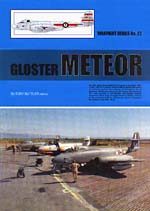 Buttler, Tony, Gloster Meteor, Warpaint Series No. 22 Bartlett, Norman, With the Australians in Korea. Canberra: Australian War Memorial, 1954 Cull and Newton, With the Yanks in Korea. England, Dec., 2000 Donselar, Annette, (Ed.), compiled by Wayne Brown, Andrew Cork, Colin Faggo Swift To Destroy - An illustrated History of 77 Squadron RAAF, 1942 - 1986 ; Norman Morris Printers ; Newcastle, Australia, 1986 Dorr, Robert F. and Warren Thompson. The Korean Air War. Osceola, WI: Motorbooks, 1994. Hill, Brian L., Wirraway to Hornet : a history of the Commonwealth Aircraft Corporation Pty Ltd, 1936 to 1985; Bulleen, Vic. : Southern Cross Publications, 1998 Futrell, Robert Frank. The United States Air Force in Korea, 1950-1953. Washington, DC: Office of Air Force History, 1983. Odgers, George. Across the Parallel: The Australian 77th Squadron with the United States Air Force in the Korean War. Melbourne: William Heinemann Ltd, 1953 Ashley, Glenn, Meteor in Action, Aircraft Number 152, Squadron/Signal Publications, Carrollton, Tx, USA Cover Image: Gloster Meteor F.Mk.8 (A77-851) as flown by Sgt. George Hale in Korea, (77 Squadron, RAAF), c.1951 Pentland Geoffrey, Malone Peter : Aircraft of the RAAF 1921-71 - Jubilee Issue ; Melbourne: Kookaburra Technical Publications, 1971 Stephens, Alan. Going Solo: The Royal Australian Air Force 1946-1971. Canberra: AGPG Press, 1995 Wackett L.J. : Aircraft Pioneer. An autobiography. ; Angus & Robertson. 1972 Wilson, David, Lion over Korea : 77 Fighter squadron, RAAF, 1950-53. Belconnen, A.C.T. : Banner Books, 1994 Meteor, Sabre and Mirage In Australian Service Wilson, Stewart
Chronological outline of the Korean conflict
Korean War 50th Anniversary - USAF Museum
Korean War 50th Anniversary- Glossary
The Cottonpickers
The Cottonpickers- Kimpo
Korean War Museum
The Aviation Art of Taylor, Trudgian and West
|
© Copyright 1999 CTIE - All Rights Reserved - Caution |